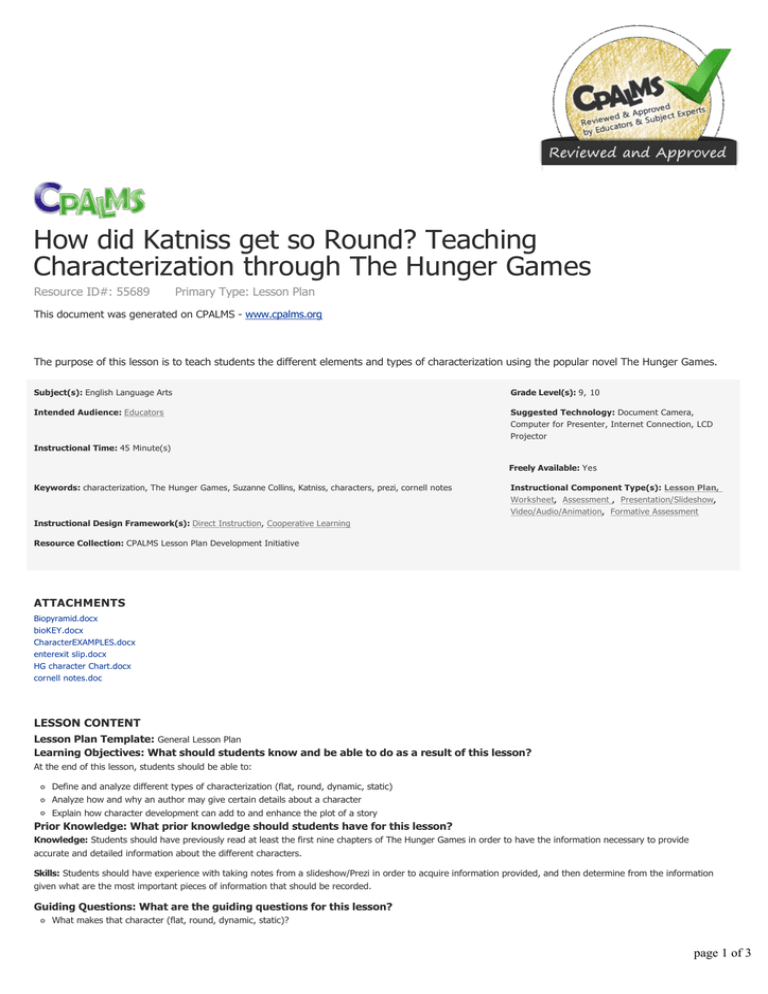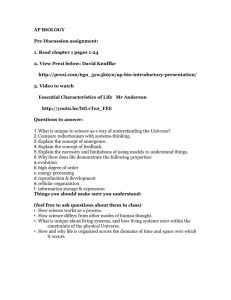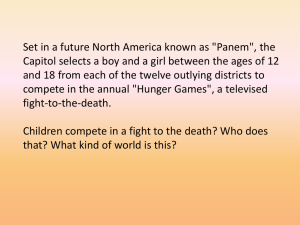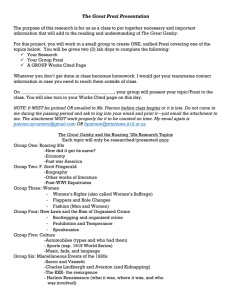Hunger Games Characterization Lesson Plan for High School
advertisement

How did Katniss get so Round? Teaching Characterization through The Hunger Games Resource ID#: 55689 Primary Type: Lesson Plan This document was generated on CPALMS - www.cpalms.org The purpose of this lesson is to teach students the different elements and types of characterization using the popular novel The Hunger Games. Subject(s): English Language Arts Grade Level(s): 9, 10 Intended Audience: Educators Suggested Technology: Document Camera, Computer for Presenter, Internet Connection, LCD Projector Instructional Time: 45 Minute(s) Freely Available: Yes Keywords: characterization, The Hunger Games, Suzanne Collins, Katniss, characters, prezi, cornell notes Instructional Component Type(s): Lesson Plan, Worksheet, Assessment , Presentation/Slideshow, Video/Audio/Animation, Formative Assessment Instructional Design Framework(s): Direct Instruction, Cooperative Learning Resource Collection: CPALMS Lesson Plan Development Initiative ATTACHMENTS Biopyramid.docx bioKEY.docx CharacterEXAMPLES.docx enterexit slip.docx HG character Chart.docx cornell notes.doc LESSON CONTENT Lesson Plan Template: General Lesson Plan Learning Objectives: What should students know and be able to do as a result of this lesson? At the end of this lesson, students should be able to: Define and analyze different types of characterization (flat, round, dynamic, static) Analyze how and why an author may give certain details about a character Explain how character development can add to and enhance the plot of a story Prior Knowledge: What prior knowledge should students have for this lesson? Knowledge: Students should have previously read at least the first nine chapters of The Hunger Games in order to have the information necessary to provide accurate and detailed information about the different characters. Skills: Students should have experience with taking notes from a slideshow/Prezi in order to acquire information provided, and then determine from the information given what are the most important pieces of information that should be recorded. Guiding Questions: What are the guiding questions for this lesson? What makes that character (flat, round, dynamic, static)? page 1 of 3 What do you think is the purpose for that character detail? How could this character be developed more? What do the physical descriptions of the characters tell us? How do the characters' pasts influence their behavior now? How do the characters' difficult situations shape their current motivations? Teaching Phase: How will the teacher present the concept or skill to students? 1. As students walk into the classroom, the teacher should hand each student an entrance/exit slip. Students should be instructed to write what kind of character they think Katniss Everdeen (from The Hunger Games) is on side one of their slips. Have them add details that they know about this character. 2. The teacher will now ask the class to share their ideas. Answers should be recorded on the board where students can see them, so they can add and take away ideas as their understanding grows. 3. Next, the teacher should use this Prezi (a free online tool similar to PowerPoint - this presentation is public and available for use!) to instruct students on the different types of characters. 4. The slides on the Prezi will give students actual definitions of the different types of characterization (flat, static, dynamic, round), as well as explain how an author may introduce characterization (direct and indirect). The teacher should instruct students to take notes on these definitions. (Have students use this template if they take notes using the Cornell note-taking method.) 5. The final two slides of the Prezi ask students to have a discussion about what they have learned and relate it to the characters in The Hunger Games. The last slide is a video review of what they have learned (only play to halfway point) which should appeal to visual learners. The teacher should now break students into small groups and instruct them to answer the 3 questions presented on the second to last slide of the Prezi. Students should answer in complete sentences and use examples from the text to support their answers. Allow students approximately 5 minutes to complete this activity. Once finished, review and have a whole class discussion so that students can justify and explain their answers to others. Guided Practice: What activities or exercises will the students complete with teacher guidance? 1. Now that all students are familiar with how to identify different types of characters, pass out the Biopyramid handout and have students complete the assignment individually for a few minutes. This assignment will ask students to look at the main character from The Hunger Games (Katniss Everdeen) and examine several factors that contribute to her being labeled a dynamic and round character. 2. While students are working, the teacher should be circulating around the room to ensure that all students are actively working and understanding the assignment. If necessary, help students locate areas of the text where the author provides more details about the character (round) or where the character begins to see or act differently about something (dynamic). Once students have had a chance to work on this alone, come back as a whole class and share out, exchanging ideas so that those students who may still be confused, can see how much information their classmates were able to identify (possibly complete a biopyramid together on the board). 3. Once students feel comfortable applying what they have learned to Katniss, hand out the character chart. Work together to complete the first two characters, (see the key) pulling information from the text to help students identify specifics about Katniss and Primrose. Independent Practice: What activities or exercises will students complete to reinforce the concepts and skills developed in the lesson? For independent work, students should complete the third character on their chart, Gale Hawthorne. Students must locate all information necessary to fill out all boxes completely. Once students have finished, they should share their answers with the teacher, so they can be provided feedback before continuing on to the rest of the chart (summative assessment). Closure: How will the teacher assist students in organizing the knowledge gained in the lesson? To close the lesson, students should write what type of character they think Mrs. Everdeen is on side two of their entrance/exit slip, and provide at least two reasons why they believe this to be true. Summative Assessment Students will complete the character chart on different characters from The Hunger Games. The questions are intended to elicit student responses that demonstrate both their understanding and application of the elements and types of characterization. Formative Assessment During the Teaching Phase, the teacher will circulate around the room, assessing students' prior knowledge of characterization while students are completing their entrance slip. While students are taking notes on the information in the Prezi, the teacher will clarify students' understanding of the different types of characters (static, dynamic, round, flat). Students should be able to explain not only what the different character types are, but also give examples as to what makes each character in the story fit that definition. Throughout the Guided Practice section of the lesson, the teacher will circulate around the room and assess students' understanding of characterization by observing student responses with the biopyramid. Additionally, while students are working together to complete the first two characters in their character charts, the teacher can ask questions such as the ones below to prompt deeper understanding: What does this character look like? What do we know about their personality? What do other characters think of this person? Are they a main or secondary character? How do you know? What makes a character round? Dynamic? What makes a character flat? Static? Where in the story can we find textual evidence to support our analysis? In the Independent Practice portion of this lesson, the teacher should be available to students if they are having trouble identifying where certain traits about Gale Hawthorne can be located in The Hunger Games. Finally, the teacher can observe student understanding of all concepts via students' responses on the exit slips. Feedback to Students During the Teaching Phase, the teacher will provide feedback to students based on the responses they produce during class discussion and independent work. The teacher should also provide feedback to students about the accuracy and quality of their work throughout both the Guided and Independent Practice portion of the page 2 of 3 lesson. ACCOMMODATIONS & RECOMMENDATIONS Accommodations: For ESE students, or those with special needs, it may be helpful to provide these students with a printed copy of the Prezi that they can take notes on as the class reviews the definitions. This way, students will not have to focus as much on the task of taking notes, and will be able to focus more on acquiring the content provided in the presentation. When students work to complete the group assignment, pairing students with different abilities may assist some students to help reinforce presented concepts. In addition, this link may be helpful for students who are really struggling with the concepts of characterization: http://www.readwritethink.org/files/resources/lesson_images/lesson800/Characterization.pdf Extensions: Students who grasp these concepts quickly and have time to advance can be given page two of the character chart. These characters are less developed characters, so students will have to search more to find all of the information for them. The biopyramid activity could be completed with any story as long as there is a well-developed main character that students can analyze and examine. The character chart can be altered to fit any other story, or could be extended for students to use with later chapters from The Hunger Games. Suggested Technology: Document Camera, Computer for Presenter, Internet Connection, LCD Projector Special Materials Needed: Teacher: Prezi Sample completed biopyramid Sample character examples Students: Cornell notes sheet Biopyramid worksheet Character Chart Enter/Exit slip Further Recommendations: Depending upon which operating system and the browser teachers have available, the Prezi may not open. Teachers will want to determine which Internet browser will accommodate the Prezi. SOURCE AND ACCESS INFORMATION Contributed by: Caitlyn Likens Name of Author/Source: Caitlyn Likens District/Organization of Contributor(s): St. Johns Is this Resource freely Available? Yes Access Privileges: Public License: CPALMS License - no distribution - non commercial Related Standards Name LAFS.910.RL.1.3: LAFS.910.L.3.6: Description Analyze how complex characters (e.g., those with multiple or conflicting motivations) develop over the course of a text, interact with other characters, and advance the plot or develop the theme. Acquire and use accurately general academic and domain-specific words and phrases, sufficient for reading, writing, speaking, and listening at the college and career readiness level; demonstrate independence in gathering vocabulary knowledge when considering a word or phrase important to comprehension or expression. page 3 of 3




